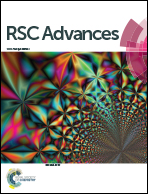Anion exchange membranes by bromination of benzylmethyl-containing poly(arylene ether)s for alkaline membrane fuel cells
Abstract
Functionalized quaternary ammonium poly(arylene ether)s (QBMPAEs) containing tetramethyl triphenyl methane moieties are synthesized via polycondensation, benzylic bromination, quaternization, and alkalization. The structures of the QBMPAEs ionomers have been confirmed by 1H NMR. The water uptakes, ion exchange capacities (IEC), hydroxide ion conductivities, and mechanical properties, as well as the thermal and chemical stabilities of the QBMPAEs membranes have been assessed. The IECs of the ionomers range from 0.90 to 1.73 mmol g−1 and can be controlled via the conditions of the bromination reaction. The hydroxide ion transport activation energy (Ea) of the QBMPAEs membranes varies from 8.01 to 10.02 kJ mol−1. The QBMPAE-d membrane with an IEC value of 1.73 mmol g−1 bears a sulfone/ketone structure and demonstrates the highest conductivity (46.6 mS cm−1) at 80 °C. The QBMPAE-d membranes conditioned in 1–10 M NaOH at room temperature for 30 days display conductivity higher than that of the parent membrane. An H2/air single fuel cell with a membrane electrode assembly (MEA) made entirely in-house from QBMPAE-d achieves a peak power density of 20.1 mW cm−2 with 0.1 mg (Pt) cm−2 as the anode and 0.2 mg (Pt) cm−2 as the cathode at 70 °C. The properties of the ionomers membranes demonstrate their potential applications in alkaline fuel cells.


 Please wait while we load your content...
Please wait while we load your content...